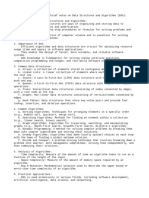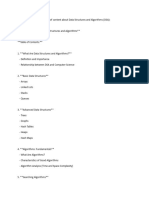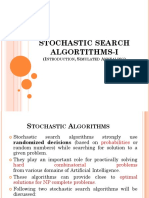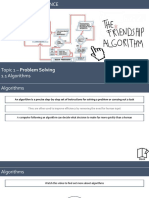Page 1 – Introduction to Data Structures and Algorithms (DSA) Data Structures and Algorithms
(DSA) form the foundation of computer science and software development. A data structure is a
way of organizing, managing, and storing data for efficient access and modification. An algorithm is
a step-by-step procedure to solve a problem. Together, DSA helps in writing optimized code that is
both time-efficient and space-efficient.
DSA is important for developing problem-solving skills and is a key subject in competitive
programming, technical interviews, and real-world software development. Mastery of DSA ensures
that developers can create scalable and high-performing applications.
Page 2 – Importance of DSA The importance of DSA lies in its ability to optimize resource usage.
For example, using the correct data structure can reduce the complexity of a problem from hours to
seconds. Some benefits of learning DSA include: 1. Efficient problem-solving and coding skills. 2.
Strong foundation for advanced subjects like Operating Systems, Databases, and AI. 3. Essential
for cracking coding interviews in top IT companies. 4. Helps in analyzing and improving the
performance of applications.
Page 3 – Types of Data Structures There are two main types of data structures:
1. Linear Data Structures – Elements are arranged sequentially. - Arrays: Collection of elements
stored in contiguous memory locations. - Linked Lists: A sequence of nodes where each node
points to the next. - Stacks: Follows Last In First Out (LIFO) principle. - Queues: Follows First In
First Out (FIFO) principle.
2. Non-Linear Data Structures – Elements are not sequential but hierarchical or interconnected. -
Trees: Hierarchical structure with a root node and child nodes. - Graphs: Collection of nodes
(vertices) connected by edges.
Page 4 – Algorithms in DSA Algorithms are the backbone of problem-solving. Some important
types include: 1. Searching Algorithms – Linear Search, Binary Search. 2. Sorting Algorithms –
Bubble Sort, Merge Sort, Quick Sort, Heap Sort. 3. Recursion and Divide & Conquer – Breaking
down problems into smaller subproblems. 4. Greedy Algorithms – Choosing the best option at each
step to get an optimal solution. 5. Dynamic Programming – Solving problems by breaking them into
overlapping subproblems and storing results. 6. Graph Algorithms – Dijkstra’s Algorithm, BFS, DFS,
Kruskal’s and Prim’s algorithms.
Page 5 – Applications of DSA DSA has applications in almost every field of computer science: -
Databases: Indexing and searching use trees and hash tables. - Networking: Routing algorithms
use graph theory. - Artificial Intelligence: Pathfinding algorithms like A*. - Operating Systems: CPU
scheduling and memory management use queues and trees. - E-commerce: Recommendation
systems and searching algorithms. - Cybersecurity: Hashing and encryption techniques.
Page 6 – Conclusion and Future Scope DSA is not just an academic subject but a practical toolkit
for every programmer. By mastering DSA, one learns how to approach problems logically and
implement efficient solutions. The future of computing, including areas like Artificial Intelligence, Big
Data, and Cloud Computing, relies heavily on DSA concepts.
Conclusion: Data Structures and Algorithms are the backbone of computer science. They provide
the efficiency, scalability, and logical foundation needed for solving real-world problems. Every
aspiring software engineer must have strong knowledge of DSA to excel in their career and
contribute to technological advancements.





















































































